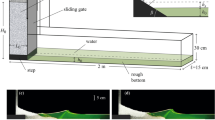Abstract
Tsunami generation from submarine landslides depends mainly on the volume of the slide material and also on other factors which include: angle of the slide, water depth, density of the slide material, the speed with which the material moves, duration of the slide, etc. Based on an incomplete data set of volume V of slide versus maximum amplitude H of the resulting tsunami waves, gleaned through available literature, a simple linear regression relationship was developed. Another partial data set was developed also from published literature, on V versus H values, based on numerical models. It was found that the agreement between the results of the numerical simulations and the observations is rather poor. It is not clear why this is so, and which data set is of questionable relevance. This is not to cast doubt on numerical models that do not use volume of the slide in an explicit manner
Access this chapter
Tax calculation will be finalised at checkout
Purchases are for personal use only
Preview
Unable to display preview. Download preview PDF.
Similar content being viewed by others
References
Anon(1980),Tsunami Struck the French Rivera,International Tsunami Information Centre, Newsletter, 13(1), 10.
Blyth, F. G. H. and De Fretias, M. H., A Geology for Engineers (Edward Arnold, Pitman Press, Bath 1974).
Bolt, B. A., Horn, W. L., Macdonald, G. A., and Scott, R. F. Geological Hazards (Springer-Verlag, Berlin, 1975) 328 pp.
Bornhold, B. D. and Harper, J. R., Engineering Geology of the Coastal and Nearshore Canadian Cardillera, Proc. 8th Int. Congress, Int. Assoc. for Engineering Geology and the Environment, Sept 98
Vancouver, Canada (A.A. Balkema/Rotterdam/Brookfiled, 1998) pp. 63–75.
Campbell, P. A. and Nottingham, D. (1999), Anatomy of a Landslide-Created Tsunami at Skagway Alaska, November 3, 1994, Science of Tsunami Hazards 17(1), 19–48.
Cornforth, D. H. and LOwell, J. A., The 1994 submarine slope failure at Skagway, Alaska. In: Landslides, Vol. 1 (K. Senneset ed.) (Balkema, Rotterdam, 1996) pp. 527–531.
Harbitz, C. B., Pedesen, G., and Gjevik, B. (1993), Numerical Simulation of Large Water Waves Due to Landslides J. of Hydraulic Engin. 19(12), 1325–1342.
Heinrich, P. (1992), Nonlinear Water Waves Generated by Submarine and Aerial Landslides, J. of Water Ways, Port Coastal and Ocean Engin. ASCE, 118(3), 249–266.
Jiang, L. and Leblond, P. H. (1992), The Coupling of a Submarine Slide and the Surface Waves which it Generates J. of Geo. Phys. Res. 97(C8), 12,731–744.
Jiang, L. and Leblond, P. H. (1993), Three-Dimensional Modeling of Tsunami Generation Due to a Submarine Mudslide, J. of Phys. Oceanography. 24(3), 559–572.
Kulikov, E. A., Fine, I. V., Rabinovich, A. B., Bornhold, B. D., and Thomson, R. E. (1999), Numerical Simulation of Submarine Landslides and Tsunami in the Strait of Georgia Proc. of the 1999 Canadian Coastal Conf. May 1999, Victoria, BC, Canada, 2, 845–862.
Kulikov E. A. Rabinovich, A. B., Thomson, R. E., and Bornhold, B. D. (1996), The LandslideTsunami of November 3, 1994, Skagway Harbor, Alaska J. of Geo. Phys. Res. 101(C3), 6609–6615.
Mader, C. O. (1997) Modelling the Skagway Tsunami Science of Tsunami Hazards 15(1), 41–48.
Mclean, A. C. and GRIBBLE, C. D., Geology for Civil Engineers (George Allen and UNWIN, London, 1979), 310 pp.
Muller, D. (1994), Physical Modelling and Field Measurements of Impulse Waves, Proc. of the Int. Symp: Waves-Physical and Numerical Modelling, Univ. of British Columbia, Vancouver, Canada, Aug. 1994, I, 307–315.
Murty T. S. (1979), Submarine Slide-generated Water Waves in Kitimat Inlet, British Columbia J. Geo. Phys. Res. 84(C12), 7777–7779.
Nottingham, D. (1999), October 166 Tsunami, personal communication. 4 pp.
Rabinovich, A. B., Thomson, R. E., Kulikov, E. A., BORHNOLD, B. D., and FINE, I.V. (1999), The Landslide Generated Tsunami of November 3, 1994 in Skagway Harbor, Alaska: A Case Study, Geo. Phys. Res. Lett. 26(19), 3009–3012.
Raichlen, F., Lee, J. J., Petroef, C., and Watts, P. (1996), The Generation of Waves by a Landslide:Skagway, Alaska-A Case Study, Chapter 101 in Coastal Engineering 1996, (B.L. Edge ed.), Proc. of 25th Int. Conf., ASCE 2, 1293–1306.
Rubino A., Backhaus, J. O., and Pierini, S. (1994), Tsunamis Generated by Mud Slides, Int. Symp:
Waves-Physical and Numerical Modelling, Univ. of B.C. Vancouver, Canada, 466–473.
Rzadkiewicz, R., Heinrich, P., Savoye, B., and Bourillet, J. F. (1998), Numerical Modelling of a Land
Slide Tsunami: The 1979 Nice event (French Riviera), Abstract, Int. Conf. on Tsunamis, Paris, France,May 1998, 26–28.
Streim, H. L. and Miloh, T. (1976), Tsunamis Induced by Submarine Slumpings off the Coast of Israel Int. Hydrographie Rev. LIII(2), 41–55.
Tsiji, Y. and Husni, M. (1998), The landslide tsunami of Waiteba Bay of July 19, 1979, Lomblen Island, Indonesia,Prof. of Int. Workshop on Tsunami Disaster Mitigation, January 1998, Tokyo, Japan, Japan Meteorological Agency and Science and Technology Agency, 87.
Watts, P. (1998), Wavemaker Curves for Tsunamis Generated by Underwater Landslides. J. of Waterway, Port, Coastal and Ocean Engin. ASCE 124(3), 127–137.
Whitten, D. G. A. and Brooks, J. R. V., The Penguin Dictionary of Geology (Penguin Books. New York, 1981), 493 pp.
Author information
Authors and Affiliations
Editor information
Editors and Affiliations
Rights and permissions
Copyright information
© 2003 Springer Basel AG
About this chapter
Cite this chapter
Murty, T.S. (2003). Tsunami Wave Height Dependence on Landslide Volume. In: Bardet, JP., Imamura, F., Synolakis, C.E., Okal, E.A., Davies, H.L. (eds) Landslide Tsunamis: Recent Findings and Research Directions. Pageoph Topical Volumes. Birkhäuser, Basel. https://doi.org/10.1007/978-3-0348-7995-8_17
Download citation
DOI: https://doi.org/10.1007/978-3-0348-7995-8_17
Publisher Name: Birkhäuser, Basel
Print ISBN: 978-3-7643-6033-7
Online ISBN: 978-3-0348-7995-8
eBook Packages: Springer Book Archive




